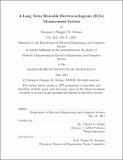| dc.contributor.advisor | Charles G. Sodini. | en_US |
| dc.contributor.author | Delano, Margaret K | en_US |
| dc.contributor.other | Massachusetts Institute of Technology. Dept. of Electrical Engineering and Computer Science. | en_US |
| dc.date.accessioned | 2013-02-13T21:23:25Z | |
| dc.date.available | 2013-02-13T21:23:25Z | |
| dc.date.copyright | 2012 | en_US |
| dc.date.issued | 2012 | en_US |
| dc.identifier.uri | http://hdl.handle.net/1721.1/76811 | |
| dc.description | Thesis (M. Eng.)--Massachusetts Institute of Technology, Dept. of Electrical Engineering and Computer Science, 2012. | en_US |
| dc.description | This electronic version was submitted by the student author. The certified thesis is available in the Institute Archives and Special Collections. | en_US |
| dc.description | Cataloged from student-submitted PDF version of thesis. | en_US |
| dc.description | Includes bibliographical references (p. 101-102). | en_US |
| dc.description.abstract | In this thesis, a low-power, wearable monitoring system was developed from discrete electronic components and custom PCBs. The device was designed to maximize comfort and minimize the footprint on the user. A single lead, clinical grade electrocardiogram (ECG), along with 3 axes of acceleration are recorded while a user wearing the device carries out his/her daily activities. The monitor itself consists of a central PCB that contains an electrode and the majority of the electronics, along with either one or two additional electrodes that are connected to smaller electrode PCBs. The monitor can be configured such that any given electrode can act as an input or an output. The system can record ECG and acceleration for over 1 week and consumes 7.3 mW. To confirm the quality of the ECG recorded by the device, a clinical test was performed. Individuals wore both the device discussed in this thesis and a clinical ECG recorder while engaging in physical activities such as sitting, standing, and running. Four participants have been tested at this time. QRS sensitivity and QRS positive predictability were determined for each ECG trace. The cardiac monitor outperformed the clinical recorder in all interventions. It should be a viable alternative to | en_US |
| dc.description.statementofresponsibility | by Margaret (Maggie) K. Delano. | en_US |
| dc.format.extent | 102 p. | en_US |
| dc.language.iso | eng | en_US |
| dc.publisher | Massachusetts Institute of Technology | en_US |
| dc.rights | M.I.T. theses are protected by
copyright. They may be viewed from this source for any purpose, but
reproduction or distribution in any format is prohibited without written
permission. See provided URL for inquiries about permission. | en_US |
| dc.rights.uri | http://dspace.mit.edu/handle/1721.1/7582 | en_US |
| dc.subject | Electrical Engineering and Computer Science. | en_US |
| dc.title | A long term wearable electrocardiogram (ECG) measurement system | en_US |
| dc.title.alternative | Long term wearable ECG measurement system | en_US |
| dc.title.alternative | Long term wearable electrocardiogram measurement system | en_US |
| dc.type | Thesis | en_US |
| dc.description.degree | M.Eng. | en_US |
| dc.contributor.department | Massachusetts Institute of Technology. Department of Electrical Engineering and Computer Science | |
| dc.identifier.oclc | 824151339 | en_US |
